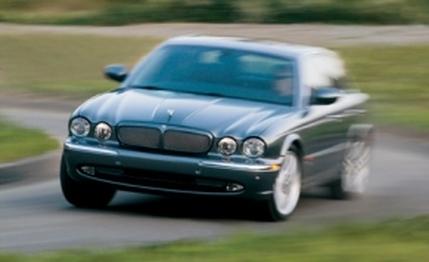
 Road Test
Road Test
Jaguar's engineers are happy to point out that the seventh-generation XJ-series cars are the first aluminum monocoque structures to be built at Castle Bromwich since the Spitfire fighter aircraft during World War II. It's perhaps no coincidence, then, that these XJ Jaguars are built using aerospace techniques (in this case bonded and riveted sheetmetal with extruded and cast aluminum structural members) instead of around a space-frame concept (like Audi's A8), which was considered unnecessarily complex.
The result, they say, is a car some 200 pounds lighter than its predecessor, with an interior nearly 20 percent larger and a structure 60 percent stiffer. Lighter is obviously better; lighter and more rigid are better yet, providing a more stable platform for the suspension and powertrain. And when you have nearly 400 horsepower to harness, as does the supercharged XJR model tested here, a stiff structure is essential.
Although the 2004 XJR wears an all-new aluminum body, the car's powertrain—a force-fed 4.2-liter V-8 and a six-speed automatic transmission—has already been sampled in XKR and S-type R variants, so we suspected it would provide strong and smooth thrust. And it did. The Eaton blower spins five percent faster than in the previous XJR, blowing 13.1 pounds of boost down the engine's 16 eager little inlet throats, helping churn out 399 pound-feet of torque at a relatively low 3500 rpm.
Obviously, the light weight of the car (just 4000 pounds) helps acceleration, but the propulsion provided by nearly 400 pound-feet of torque has to be felt to be appreciated. In the XJR, a dab at the throttle picks up the car and wafts it away from other vehicles on a virtual wave of torque.
The smooth V-8 pedals through a plush six-speed ZF transmission, and careful electronic calibration has the two whirling in well-orchestrated unison. When cruising at normal speeds, the engine responds to a hard jab at the pedal with a brief pause as the autobox digs for an appropriate ratio, then it thrusts the occupants back into their seats with another long surge of acceleration.
But just as with the S-type R we tested in our May 2002 issue, Jaguar's published specs seem to run into literal contradictions. Maximum power is reported to be available at 6100 rpm, yet the tachometer is redlined at 6000, and the automatic transmission shifts at that point. Nonetheless, our car swooped to 60 mph in 5.3 seconds (in its press materials, Jaguar promises a 5.0-second time) and on through the quarter-mile in a respectable 13.9 seconds at 104 mph.
That puts the car right into the hunt with the Mercedes S55 AMG and BMW 760Li, at a base price—$74,995—that's $30,000 to $40,000 lower than those esteemed models'. (The unboosted XJ8 starts at $59,995 and should perform on par with entry S-class and 7-series models.) If this Jaguar can live up to the promises of greatly improved quality and reliability that Jag officials—and the car's extended durability trials—suggest, this will truly be a case of a cat among the pigeons.
Certainly, the XJR held up well during its short tenure in the C/D realm, starting and performing reliably, and showing evidence of more careful assembly and painting processes than Jags of yore. Only the curious behavior of a front distance sensor hinted at electronic malfeasance.
This radar-based sensor, which works as a device that informs the adaptive cruise-control system to maintain safe distances behind other vehicles or as a simple following-distance warning device when the cruise control is deactivated, would occasionally return to duty and emit warning beeps even when switched off. It's possible this is normal, with the sensor abandoning a state of passive scrutiny at a preset threshold, in which case it is simply annoying rather than defective. If so, we really have no evidence to suggest that the new XJs will be anything but rock solid.
For people concerned about the vulnerability of the all-aluminum body, Jaguar's engineers insist that the bake-hardened alloy used on the car's outer skin is more resistant to dings than normal steel panels and that high-ductility alloy provides better protection in collisions. In addition, the XJR features bolt-on front and rear structures for quick and simple replacement of damaged extremities.